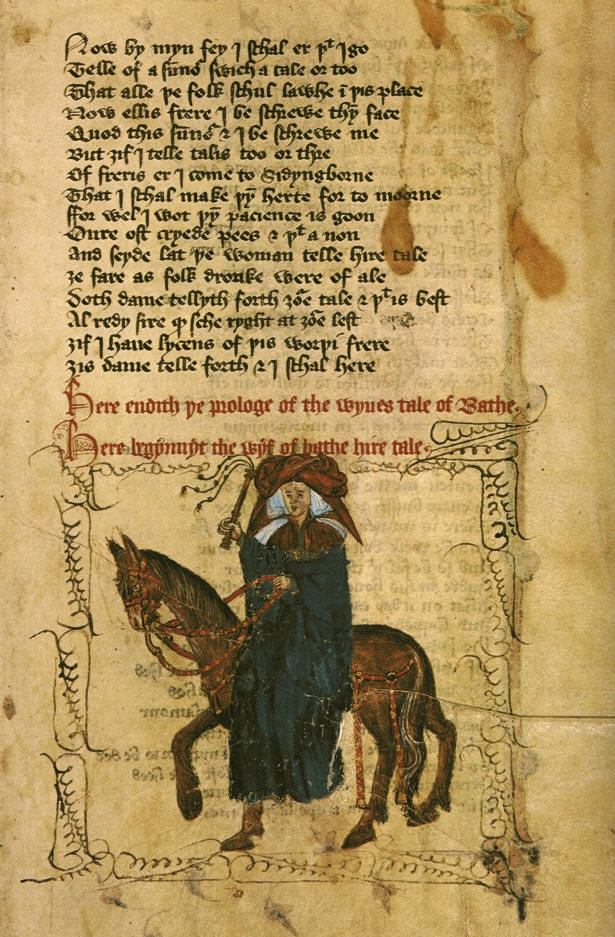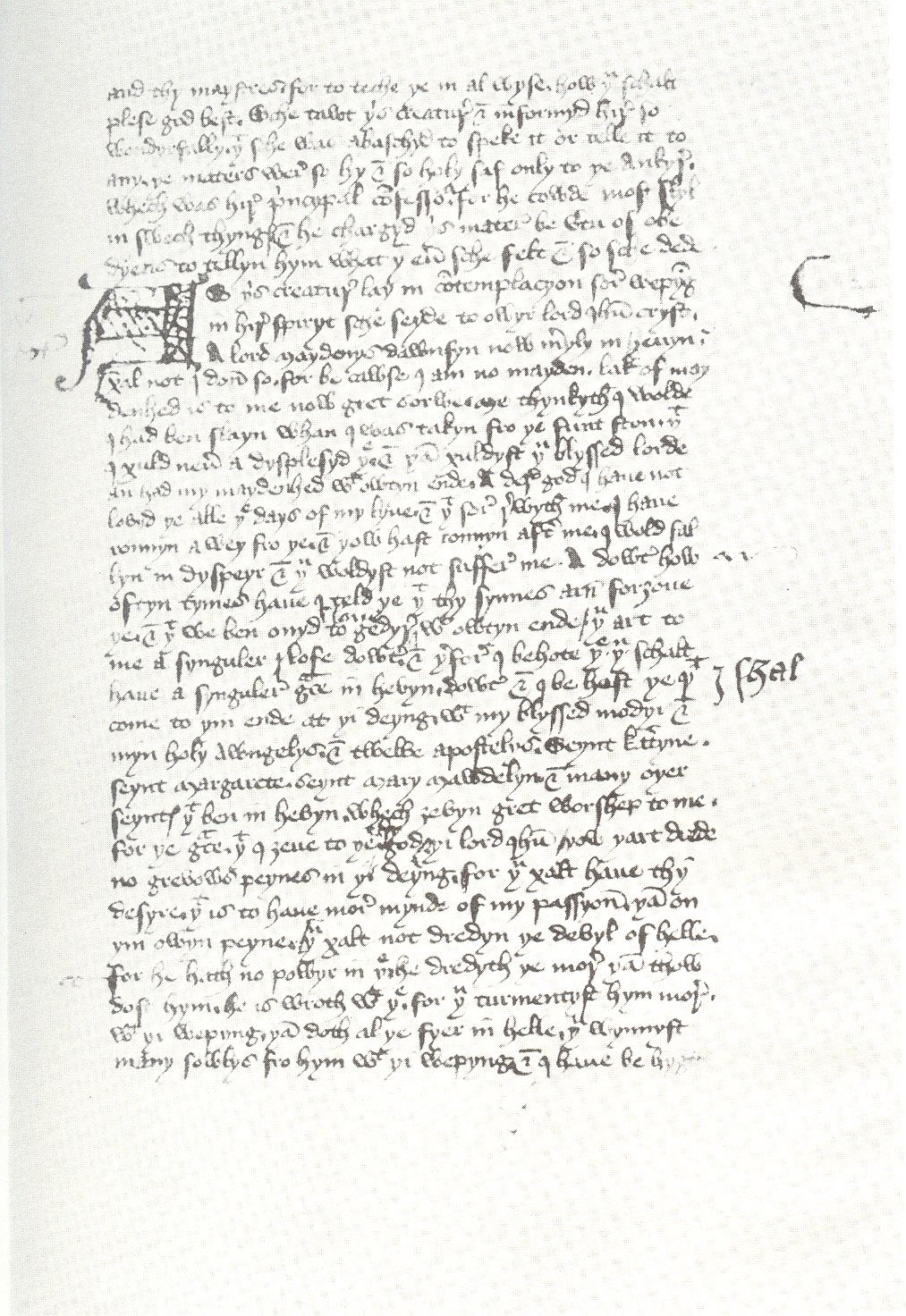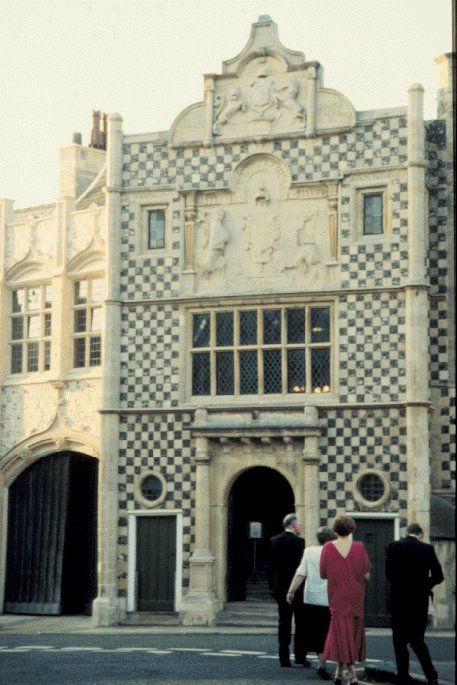The Wife of Bath’s Prologue and Tale, the Parson's
Prologue and Tale, and the Retractions
Key terms: antifeminist or misogynist literature; romance;
flat vs. round characters; experience, auctoritee, maistrye,
spiritual autobiography, mystic
 The
Middle Ages had, to put it mildly, a woman problem.
Women were part of two of
the three estates (those who worked and those who prayed), but yet they were
also a fourth estate outside the system. They were viewed—legally, morally, and
spiritually—as extensions of the men in their lives, dependent upon either a
father or other kinsman as protector, or legally identical to their husbands. It
was very rare for a woman to be a femme sole under the law and own
property; medieval law was far more comfortable with femmes couvert,
women who were “covered” by some man’s control. (In fact, in the 15th
century, the average time for a London mercantile-class widow to remarry was
around a month.)
The
Middle Ages had, to put it mildly, a woman problem.
Women were part of two of
the three estates (those who worked and those who prayed), but yet they were
also a fourth estate outside the system. They were viewed—legally, morally, and
spiritually—as extensions of the men in their lives, dependent upon either a
father or other kinsman as protector, or legally identical to their husbands. It
was very rare for a woman to be a femme sole under the law and own
property; medieval law was far more comfortable with femmes couvert,
women who were “covered” by some man’s control. (In fact, in the 15th
century, the average time for a London mercantile-class widow to remarry was
around a month.)
The Church provided the underpinning for this status. It
saw women as essentially duplicitous. One the one side, they were images of the
Virgin Mary—the mother, nurturer, intercessor, chaste and worshipped on their
pedestals. The term used by Gabriel to greet Mary in the gospels—Ave gratia
plena [Hail, full of grace!] is used to summarize this position.
At the same time, the Church taught, women were descendents
of Eva [Eve]—and thus instruments of temptation and sin. They were
carnal, not spiritual; they dragged men down by the lure of their physicality.
When men desired a woman spiritually, they committed a sin; thus, women were the
instruments of men’s damnation.
Men were expected to chastise women—to keep them in their
place, reduce their ability to tempt me, and above all maintain control (maistrye
or sovereintee) over the women in their lives. (Wife-beating or
daughter-beating was in fact legal within certain constraints, since women
obviously were so intellectually weak that you couldn’t convince them to change
their ways through reasoned argument. <<irony!!!>>) Letting a woman run things
is an admission that men were not doing their spiritual duties. A whole genre of
misogynist or antifeminist literature sprang up that told of the dangers caused
by wicked women—much like the book Jankyn reads to Alys.
So when Chaucer comes to represent a carnal woman in the
Canterbury Tales, he has a difficult choice to make: does he represent the
Ave side or the Eva side? He chooses Eva, and in doing so,
creates the first round character in English literature—the Wife of Bath.
Evidence in the unfinished Tales suggests that
Chaucer originally had a more flat, stereotyped character in mind for the Wife,
who probably would have told the very coarse fabliau that survives as the
Shipman’s Tale. Instead, as he created her character, he seems to have fallen in
love with his own creation—and the Alys he creates jumps off the page at us as a
vibrant, if spiritually misguided figure.
From her first sentence—“Experience, though noon auctoritee
is in this world, is right enough for me to speak of wo that is in marriage”—Alys
announces to us that she is arguing on the devil’s side, for the evidence of
physical senses (the province of the lewed) against the learned auctoritees
of clerks, government, and the Church. She turns the biblical texts upside down
to make her case that God intended women to use their bodies carnally—that after
all, if women didn’t have sex, where would the next generation of virgins come
from? She has no problem with those who choose virginity or a more spiritually
“pure” life, but she argues vigorously for the fact that using her “instrument”
with her husbands does not condemn her. In a series of famous metaphors—gold vs.
wooden dishes, white vs. barley bread, the flour vs. the bran of a grain of
wheat—she argues that who she is and what she does are perfectly defensible from
a spiritual sense. Like the Pardoner, the Wife is a vice character whose
prologue is a confession of her techniques and an exposure of her sins—yet
unlike the Pardoner, we warm to her because of her [that is to say, Chaucer’s]
good humor, her liveliness, and her considerable rhetorical skill.
She has had five husbands (and is seeking a sixth): three
elderly rich ones, whom she nagged constantly but also satisfied sexually; a
fourth “revelour” with whom she had epic sexual battles; and her fifth (and
‘true love’) Jankyn, the young clerk who marries her for her money and makes her
life a living hell by beating her, reading her antifeminist literature,
literally deafening her, and finally almost killing her. Only when he fears he
has killed her does he relent and grant her maistrye—which she
embraces by socking him in the face, then turning around and telling a tale of
what would happen if women ran things.
Her Tale, a romance, has a lady rescuing a knight
rather than a knight rescuing a lady. In an uncanny prefiguring of Freud’s
famous “What do women want,” Chaucer has the Wife tell a story of a man’s search
for the answer to that question. When he proves to be surly and unappreciative
of the woman who gives him the answer, she lectures him on gentilesse—the
true nobility of the spirit—which comes not from high-class birth but from the
soul. (How deeply ironic—in a tale whose message overthrows everything a good
medieval Christian should have believed—to have this sermon, which is apparently
“straight,” and full of sound advice.) The knight, finally chastised, yields the
sovereintee or maistrye to his wife, and in doing so gets the
happy ending he wants. The Wife’s solution reinforces her Prologue and at
the same time sets medieval spiritual values on their ear by arguing that women
should run men’s lives, and not vice-versa. She is the ultimate rebel—and you
have to love her.
The measure of Chaucer’s unease with what he created is
seen both in the Parson’s Prologue and Tale and in his Retractions,
which circulate with most copies of the Canterbury Tales. The Parson’s
Tale is a translation and adaptation of a catechism—a manual teaching strict
and standard Christian beliefs. In the “Remedy for the Sin of Lechery,” the
Parson strictly defines a wife’s duty to her husband, a husband’s
responsibilities to his wife, the limitations on sexual conduct consistent with
Christian moral practice, and celebrates chastity—all in direct contrast to the
Wife’s ebullient argument. If the Parson is an ideal figure, we have to assume
that his version is what Chaucer and his society thought was the “right”
conduct—but the popularity of the Wife of Bath’s Prologue and Tale
suggests that her argument, too, had its enthusiasts.
When Chaucer in his Retractions (traditionally
believed to be the last thing he wrote) apologies for those works that might
lead people into sin (by being too morally subtle or by making sin too
appealing), he is apologizing (and at the same taking pride in) works like
The Wife of Bath’s Prologue and Tale. It is one of the marks of his
greatness that he can reflect so many sides of a complex moral picture without
forcing a decision upon us—that he, in fact, trusts us as readers to evaluate
the conduct he portrays and the stories he tells and make our own judgments
about them.
The Book of Margery Kempe

(Margery Kempe,
c. 1373—after 1438)
Biography
from St. Margaret’s Church
An eight-page pamphlet was published by Wynken de Worde in a 500-copy edition
entitled A Short treatise of contemplation taught by our Lord Jesu Christ,
taken out of the book of Margery Kempe of Lynn. All but one copy, in
University College, Cambridge, perished, and scholars placed Margery among the
English mystics of the period, of whom there were many, such as Hilton, Rolle,
and Juliana of Norwich. In 1934, Hope Emily Allen was allowed to look at a
manuscript in the library of Col. Butler Bowdon of Pleasington Old Hall in
Lancashire. A scholar of Robert Rolle, she soon discovered that it was the book
from which de Worde had derived his pamphlet, but that it was not a book of
devotion. Instead, it was a rather massive autobiography; the first written in
English, and one of the few deep personal insights we have into the life and
thoughts of a member of the middle class of the period.
Though the manuscript was probably copied several decades after her death, it
remains our vital link to this intriguing figure in the development of medieval
thought.
Margery Kempe was the daughter of John Burnham, five times mayor of the town
of Lynn, a flourishing town of Norfolk. In 1393, Margery married John Kempe, a
young merchant of the town, and a member of the same Corpus Christi guild as her
father. Her marriage was an uneasy one, affected by, among
other factors, Margery's post-partum depression after the birth of her first
child, her increasing spirituality, and her battles with her very worldly (and
probably understandably confused and antagonistic) husband, who appears to have
been constantly in debt and at odds with his wife until later in life, when he
became seriously ill and she nursed him.
 The
King's Lynn of Margery's time was a flourishing mercantile center that
participated in a great deal of England's lucrative textile trade with the Low
Countries (Belgium, Holland, and northern Germany--all of which Margery lumps
together as "Deutschland"). The guilds of Lynn were powerful and profitable, and
a woman of Margery's connections would have been a socially recognizable person.
(See the picture of the medieval Guildhall in Lynn, on the left.) Though she
would probably have learned little to no Latin, and therefore been considered
"illiterate" by the standards of the lerned, she was undoubtedly given
enough schooling in the vernacular to read basic prayers, keep household and
business accounts, and pursue her interests in reading--which she describes
thoroughly in her Book. However, literacy among the lewed
The
King's Lynn of Margery's time was a flourishing mercantile center that
participated in a great deal of England's lucrative textile trade with the Low
Countries (Belgium, Holland, and northern Germany--all of which Margery lumps
together as "Deutschland"). The guilds of Lynn were powerful and profitable, and
a woman of Margery's connections would have been a socially recognizable person.
(See the picture of the medieval Guildhall in Lynn, on the left.) Though she
would probably have learned little to no Latin, and therefore been considered
"illiterate" by the standards of the lerned, she was undoubtedly given
enough schooling in the vernacular to read basic prayers, keep household and
business accounts, and pursue her interests in reading--which she describes
thoroughly in her Book. However, literacy among the lewed
was a dangerous, even potentially heretical skill in early fifteenth-century
England--and Margery lived in East Anglia, where anti-Lollard persecutions were
particularly fierce. Thus, she is always careful to stress that her reading is
conducted under the guidance of a spiritual director (usually a priest or monk);
that she does not "preach" but merely carries on "holy conversation;" and that
she cannot translate Latin without divine inspiration. Drawing on the models of
the lives of women like St. Bridget of Oignes, she either created the persona of
or actually used the services of a priest who wrote down her experiences for
her--thus covering her experience with the patina of auctoritee.
Many scholars repeat the statement that "Margery Kempe was illiterate" without
much consideration--but the evidence shows otherwise.
The Book is the spiritual autobiography of a medieval person
who believed she had genuine religious visions—and was compelled to witness to
her faith in ways that were far from normal in her time—especially for a woman.
In studying Margery, it’s always important to think about what role gender plays
in her actions and in her text—you might want to pay close attention to her
imagery and language choices as she describes her experience. Margery's visions
are accompanied by fits of tears and crying, and she seems to want us to feel
what Christ experienced—to put us in her and His shoes, as it were. In the
Middle Ages this was called "affective piety" and you may have experienced it
today if you have heard a sermon in an evangelical church, where it remains a
major factor in spirituality. So Margery too is emphasizing experience,
the kind of knowing available to the laity, over auctoritee, the
whole closed tradition of book learning that was controlled by the male clergy.
It’s worth considering how her emphasis, however, differs from Alys of Bath’s
focus.
 As
Lynn Staley notes in her
Introduction to
the Book, "By presenting Margery as living out a
vernacular gospel, as appearing sometimes to preach that gospel, and as
challenging the authority of confessors, priests, and bishops, Kempe sketches in
the outlines of a nation where conformity has become an end in itself and where
anyone, particularly a woman, who seeks to imitate the Christ-like life has
trouble finding tolerance, much less approval. Just as she explores the
materialistic and conformist nature of the England of Henry V, Kempe provides a
sharp look at the ecclesiastical institutions of the day. By blurring the
distinction between the ecclesiastical and secular spheres, Kempe suggests ways
in which churchmen too often resemble their secular counterparts in their desire
for conformity, worldly status, wealth, and power."
As
Lynn Staley notes in her
Introduction to
the Book, "By presenting Margery as living out a
vernacular gospel, as appearing sometimes to preach that gospel, and as
challenging the authority of confessors, priests, and bishops, Kempe sketches in
the outlines of a nation where conformity has become an end in itself and where
anyone, particularly a woman, who seeks to imitate the Christ-like life has
trouble finding tolerance, much less approval. Just as she explores the
materialistic and conformist nature of the England of Henry V, Kempe provides a
sharp look at the ecclesiastical institutions of the day. By blurring the
distinction between the ecclesiastical and secular spheres, Kempe suggests ways
in which churchmen too often resemble their secular counterparts in their desire
for conformity, worldly status, wealth, and power."
Margery pursued a number of outlets to develop her
spirituality. She confered with mystics like Julian of Norwich; she traveled on
pilgrimage to Rome and the Holy Land (each time winning permission to travel
from her husband by promising to pay his debts); and she sought out
opportunities to engage in contentious debate with clerics who didn't live up to
her standards of what religious role models should be. It's interesting to note
that there are no records of her "trials" in the ecclesiastical court records of
Lincoln, York, or Canterbury, all of which survive from her lifetime. Likewise,
there are no records that she was persecuted or disliked in her hometown; the
last records of her show her being made member in a powerful religious guild and
bequests to her in return for prayers for the donors' souls. The question
therefore arises how much of her "autobiography" is true, and how much made up
to illustrate spiritual principles and models that she felt were important for
people to read about. Some people call The Book of Margery Kempe the
first novel in English. That's probably taking things too far, but we have to
remember that Margery shaped the tale she was telling for her own authorial
purposes, just like Chaucer shapes the Wife of Bath's story.
For all the eccentricities of her spiritual practice,
Margery's Book provides one of the first and best pictures of what life
was like for a real woman, contesting for her place and identity in the
male-controlled world of late medieval England. Her voice is as distinctive and
idiosyncratic as the Wife of Bath's, and taken together they offer us an
intriguing, if incomplete, picture of medieval English womanhood.
 As a
wife and mother, Margery is no saintly virgin; she is far from an "estates
ideal" like the Parson or the Plowman in The General Prologue.
Compare/contrast her attitudes towards sex and the pleasures
of the flesh with the Wife of Bath. While the real and fictional women
are obviously very different (e.g. in their attitudes toward and enjoyment of
sex), do they have other things in common?
As a
wife and mother, Margery is no saintly virgin; she is far from an "estates
ideal" like the Parson or the Plowman in The General Prologue.
Compare/contrast her attitudes towards sex and the pleasures
of the flesh with the Wife of Bath. While the real and fictional women
are obviously very different (e.g. in their attitudes toward and enjoyment of
sex), do they have other things in common?
What is the reaction of different forms of authority (Margery's husband, the
church) to Margery's mystical experiences? How does the learned anchoress Julian
react to her? What role does gender play in these reactions? In the second
passage (NA 369), Margery accuses herself of pride-- which she regards as a sin.
Yet she is not exactly humble when she stands up to the Archbishop of York (NA
374-77). Why does she feel she can argue with the church authorities? The Wife
of Bath similarly argued for the validity of experience over scripture as a
source of authority in certain realms of human existence. Compare/contrast
Margery's and Alison's conflict with Church Authority. Who actually wrote
Margery's Book? In her case, are "author" and "authority" identical? Is
Chaucer's role analogous to that of Margery's scribe?
Study Questions for "The Wife of Bath's Prologue and
Tale"
1. What revealing details do we learn about the Wife of Bath's own
history in the first thirty lines?
2. What is the Wife opinion about virginity? How does she defend her
position?
3. The Wife bases her opinions about men upon her own extensive
experience. By way of defending her own actions, how does she explain the
relationship between herself and her first three husbands?
4. Since the Wife does not hold as scared all the moral precepts that are
part of the cultural basis of our society, how does she justify her
particular view about sexual relations between men and women?
5. The Wife sees relations between men and women as adversarial. Explain
how this informs her view of how those relations should be balanced.
6. What is the relationship between the Wife and her fourth husband? Is
their significance to her pilgrimage and his death?
7. Describe the incident that happens between the Wife and her fifth
husband, Janekin, the clerk (scholar). What are the various results of this
incident?
8. The Wife fashions her prologue so that her argument culminates just
before she tells her tale. What is the moral point she has been working up
to?
9. What are the effects of the interruptions in the Prologue? Who are
your sympathies, as a listener, with?
10. The tale, set in King Arthur's time, tells of a knight who must go
and find the answer to what question? Why is he sent on this journey?
11. What are some of the possible answers he is given along the way? What
is the correct answer?
12. Summarize what happens after he announces the answer.
13. What has the knight learned from the rape he committed, the quest set
by the Queen's Court, and his own acquiescence to the Fairy?
14. Is there any poignancy in the argument of the old woman when the
knight rejects her because she is foul and low when you consider the Wife
herself?
15. Revaluate the Wife's claim "Experience, though noon auctoritee/were
in this world, is right ynough for me/to speke of wo that is in mariage."
After comparing the man-woman relations at the end of the prologue and the
end of the Tale.
16. What similarities can you see between the tale of the Wife and "
Lanval" by Marie de France? What similarities between her life and the life
of Margery Kempe in the sections you have read?
17. How do you see the Wife at the tale's end? Is she a monster? An
apologist for women? An early feminist?
http://merlin.capcollege.bc.ca/fahlmanreid/wife_of_bath.htm
 The
Middle Ages had, to put it mildly, a woman problem.
Women were part of two of
the three estates (those who worked and those who prayed), but yet they were
also a fourth estate outside the system. They were viewed—legally, morally, and
spiritually—as extensions of the men in their lives, dependent upon either a
father or other kinsman as protector, or legally identical to their husbands. It
was very rare for a woman to be a femme sole under the law and own
property; medieval law was far more comfortable with femmes couvert,
women who were “covered” by some man’s control. (In fact, in the 15th
century, the average time for a London mercantile-class widow to remarry was
around a month.)
The
Middle Ages had, to put it mildly, a woman problem.
Women were part of two of
the three estates (those who worked and those who prayed), but yet they were
also a fourth estate outside the system. They were viewed—legally, morally, and
spiritually—as extensions of the men in their lives, dependent upon either a
father or other kinsman as protector, or legally identical to their husbands. It
was very rare for a woman to be a femme sole under the law and own
property; medieval law was far more comfortable with femmes couvert,
women who were “covered” by some man’s control. (In fact, in the 15th
century, the average time for a London mercantile-class widow to remarry was
around a month.)
 The
King's Lynn of Margery's time was a flourishing mercantile center that
participated in a great deal of England's lucrative textile trade with the Low
Countries (Belgium, Holland, and northern Germany--all of which Margery lumps
together as "Deutschland"). The guilds of Lynn were powerful and profitable, and
a woman of Margery's connections would have been a socially recognizable person.
(See the picture of the medieval Guildhall in Lynn, on the left.) Though she
would probably have learned little to no Latin, and therefore been considered
"illiterate" by the standards of the lerned, she was undoubtedly given
enough schooling in the vernacular to read basic prayers, keep household and
business accounts, and pursue her interests in reading--which she describes
thoroughly in her Book. However, literacy among the lewed
The
King's Lynn of Margery's time was a flourishing mercantile center that
participated in a great deal of England's lucrative textile trade with the Low
Countries (Belgium, Holland, and northern Germany--all of which Margery lumps
together as "Deutschland"). The guilds of Lynn were powerful and profitable, and
a woman of Margery's connections would have been a socially recognizable person.
(See the picture of the medieval Guildhall in Lynn, on the left.) Though she
would probably have learned little to no Latin, and therefore been considered
"illiterate" by the standards of the lerned, she was undoubtedly given
enough schooling in the vernacular to read basic prayers, keep household and
business accounts, and pursue her interests in reading--which she describes
thoroughly in her Book. However, literacy among the lewed
